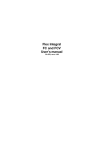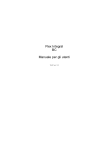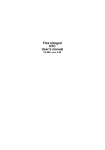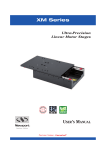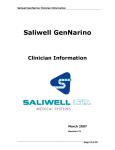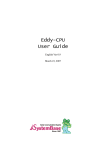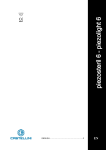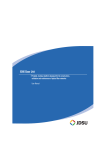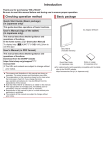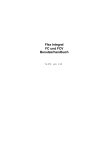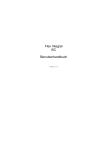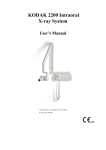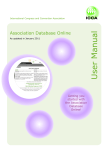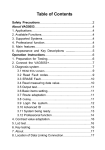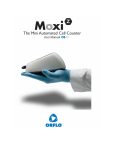Download Flex Integral BC User`s Manual
Transcript
Flex Integral BC User’s Manual YA-898 vers. 1.3 Versions log List of versions for Y A-898 Rea son Pages to be re place d First edition 22 Ne w version Date of e mission Initials 1.00 10 12 92 AR Ne w d ata for ultrasonic s caler typ e O a nd turbine type B 1, 2, 25 1.10 20 12 94 AR HygiFlex Vac Ultra, ultrasonic s caler typ e O 1, 2, 5, 6, 15, 1 6, 17, 2 3 1.20 28 03 95 AR Correction 26 1.21 10 04 97 Ne w layout + corre ctio ns an d revised ultras onic scal er type O texts All 1.3 15 01 98 Flex Integral BC , Users Manual, 1998-01-03 1. Guide 1. Guide Experience tells us that very few people read a manual before starting to operate new equipment. This is why this manual is designed as a reference book. You don’t need to read it all before starting. We do, however, suggest that you read chapter 2 GENERAL and the beginning of each chapter. The manual focuses on how the equipment works. Should you wish to learn more about optimal methods of working we recommend our Dental Software compendium. This especially applies if you have not operated Flex equipment before. We constantly improve our equipment. Your equipment may therefore deviate on a few points from the description in this manual. See more about optimal working rouitnes in our Ergonomics report. 0510 The following equipment is CE-marked according to the Medical devices directive 93/ 42/EEC, which is a subdirective of the EMC directive 92/31/EEC: Flex Integral BC Flex surgical lamp Flex Integral patient chair /2 Flex Integral BC , Users Manual, 1998-01-03 The equipment fulfills the demands of the following standards: EN 60601-1-2 EN 60601-1 EN 28601 EN 21942-1/4 EN ISO 9680 ISO 7494 ISO/DIS 11498 DS/EN 1640 DS/EN 980 prEN ISO 6875 EN ISO 9687 prEN 1041 prEN ISO 13294 3 Contents 1. Guide ..................................................................................................................................................... 3 2. General .................................................................................................................................................. 7 2.1 Power switches ............................................................................................................................... 7 2.2 Foot control ..................................................................................................................................... 7 2.3 Audio signals .................................................................................................................................. 7 3. Use ......................................................................................................................................................... 8 3.1 Surgical lamp .................................................................................................................................. 8 3.2 Patient chair .................................................................................................................................... 8 3.2.1 Control .................................................................................................................................... 8 3.2.2 Headrest ................................................................................................................................. 8 3.3 VarioFlex operator’s stool ................................................................................................................ 9 3.4 Assistant call .................................................................................................................................. 9 3.5 Cuspidor .......................................................................................................................................... 9 3.6 Cup filler .......................................................................................................................................... 9 3.7 Suction ........................................................................................................................................... 9 3.8 Instruments .................................................................................................................................. 10 3.8.1 Syringe .................................................................................................................................. 10 3.8.2 Motor ..................................................................................................................................... 10 3.8.3 Surgery plant ........................................................................................................................ 11 3.8.4 Turbine .................................................................................................................................. 12 3.8.5 Ultrasonic scaler ................................................................................................................... 12 3.8.6 Composite curing lamp ........................................................................................................ 14 3.8.7 Fibre optic probe ................................................................................................................... 14 3.9 Amalgam separator ....................................................................................................................... 15 4 Hygiene and care ................................................................................................................................. 17 4.1 Suction - HygiFlex Vac .................................................................................................................. 17 4.2 Suction - HygiFlex Vac Ultra ......................................................................................................... 17 4.3 Cuspidor and cup filler .................................................................................................................. 18 4.4 Syringe .......................................................................................................................................... 18 4.5 QuickFlex coupling ........................................................................................................................ 18 4.6 Motor ............................................................................................................................................. 18 4.7 Turbine .......................................................................................................................................... 19 4.8 Ultrasonic scaler ........................................................................................................................... 19 4.8.1 Type L .................................................................................................................................... 19 4.8.2 Type O ................................................................................................................................... 19 4.9 Composite curing lamp ................................................................................................................. 19 4.10 Fibre optic probe ......................................................................................................................... 19 4.11 Instrument pad ............................................................................................................................ 20 4.12 Surgical lamp .............................................................................................................................. 20 4.13 Surfaces ...................................................................................................................................... 20 4.14 Spray ducts ................................................................................................................................. 20 4.15 Amalgam separator ........................................................................................................................ 21 4.16 Hygiene routines ........................................................................................................................ 22 4.16.1 Daily .................................................................................................................................... 22 4.16.2 Holidays ............................................................................................................................. 22 4.17 Detergents and cleansing processes ......................................................................................... 22 5. Programming / adjusting .................................................................................................................. 23 5.1 Patient chair .................................................................................................................................. 23 5.2 Spray water ................................................................................................................................... 23 5.3 Extra ............................................................................................................................................. 23 44 Flex Integral BC , Users Manual, 1998-01-03 Contents 6. Maintenance and repairs ................................................................................................................... 6.1 Surgical lamp ................................................................................................................................ 6.1.1 Bulb ....................................................................................................................................... 6.2 Patient chair .................................................................................................................................. 6.3 QuickFlex coupling ........................................................................................................................ 6.4 Motor ............................................................................................................................................ 6.4.1 Fibre optic bulb ..................................................................................................................... 6.4.2 O-rings .................................................................................................................................. 6.5 Turbine ........................................................................................................................................... 6.5.1 Fibre optic bulb. ..................................................................................................................... 6.6 Ultrasonic scaler ........................................................................................................................... 6.6.1 Type L - replacement of the tip .............................................................................................. 6.6.2 Type O - replacement of the ferrite ....................................................................................... 6.7 Composite curing lamp ................................................................................................................. 6.7.1 Curing test ............................................................................................................................ 6.7.2 Bulb ....................................................................................................................................... 6.7.3 Light filter .............................................................................................................................. 7. Technical data ..................................................................................................................................... 8. Spare parts, accessories, etc. ........................................................................................................... 9. Guarantee conditions ......................................................................................................................... 10. Your feedback .................................................................................................................................... Flex Integral BC , Users Manual, 1998-01-03 25 25 25 25 25 26 26 26 26 26 26 26 26 28 28 28 28 29 30 34 35 5 66 Flex Integral BC , Users Manual, 1998-01-03 2. General 2. General 2.1 Power switches Switch the equipment on using (1). The chair can be switched off separately using (2). When the mains are switched on the buttons will light. 2 1 The unit will give 3 “beeps” as soon as it is operational. 2.2 Foot control The foot control is mounted on a separate unit, which is normally placed behind the chair. The pedal can be moved to the: right , left or be pressed down . 2.3 Audio signals The unit can give different types of audio signals. ● Operational signal: 1-3 short high-pitched notes (“beep”). Means ready or understood. ● Operation error signal: Low note given in the case of operational or technical error. ● Warning signal: Alternation between high and low notes. May mean overheating. If the signal doesn’t stop when the equipment has cooled, you ought to call a service technician. Flex Integral BC , Users Manual, 1998-01-03 7 3. Use 3. Use In the following we give a description of how the equipment functions when it leaves the factory. See chapter 5 for possibilities on how to change the functions. 3.1 Surgical lamp Switch on/off using... ...switch (1) towards (B) Switch on or alternate between 3 light intensities using... ...switch (1) towards (A). When you switch the lamp on it always has the light intensity last used. 3.2 Patient chair 3.2.1 Control Regulate the chair inclination and height using... ...pedal (1) towards either N ,S ,E ,W Choose a programme position using... ...pedal (2) towards either E or W Backside of the chair basis Towards N the chair will return to the prior position. Towards S you reset to the zero position. Stop a programme movement by... ...touching any of the 2 pedals. Should the chair knock against e.g. your legs, the chair will automatically stop the movement and lift itself approximately 5 cm. 3.2.2 Headrest The headrest can easily be pulled out. To push it back, press lock button (1) or (2) home. To adjust the headrest inclination, loosen the lock (3). 88 Flex Integral BC , Users Manual, 1998-01-03 3. Use 3.3 VarioFlex operator’s stool The chair is operated with the help of the 2 handles. When you pull the handle (1) up, you lift/lower the chair. When you push the handle (1) down, you can adjust the position of the back rest and thus the depth of the stool. VarioFlex operator chair, top view When you pull the handle (2) up, you adjust the seat inclination. 3.4 Assistant call Activate by... ...pressing the foot control down place. while all instruments are in You can alternatively connect, for example, a door opener. 3.5 Cuspidor Start the cuspidor flush for 30 seconds by... ...pressing the foot control pedal to the left ments are in place. while all instru- Interrupt the cuspidor flush by... ...moving the foot control pedal to the left are in place. while all instruments 3.6 Cup filler Start/interrupt the cup filler by... ...moving the foot control pedal to the right ments are in place.. while all instru- 3.7 Suction The suction is activated when a suction tube is taken down. When working without an assistant, you can pull the suction holder out. Flex Integral BC , Users Manual, 1998-01-03 9 3. Use 3.8 Instruments Instruments with Quick-Flex coupling are disconnected by pressing the 2 lock buttons (1) and (2) down. You connect the instruments by pressing the instrument down over the pointed end of the coupling. You can only connect instruments as specified in your order. If you try to connect an instrument wrongly an operation error signal will be emitted and the instrument cannot be activated. The foot control activates the first instrument taken off the suspension (not the syringe). Do not activate the foot control pedal while changing an instrument, unless the foot control is at present controlling another instrument. The connection must be dry when an instrument is connected 1 2 3.8.1 Syringe Draw off air using the right switch (1) and drain off water using the left switch (2). As an accessory the syringe can be fitted with a heating element. A green light emitting diode indicates that the heating element is on. 3.8.2 Motor Take the motor and... ● activate by moving the foot control to - the right - the left : the motor rotates clockwise : the motor rotates anti-clockwise which is indicated by a „beep“ . ● Choose a spray combination by keeping the foot control pedal pressed down , until the desired combination is displayed on the instrument bridge light emitting diodes (7). Green = water, Yellow = air. Four combinations are possible (spray, air, water, nothing). An automatic double chip blow follows after use with water. The unit can be programmed to produce a chip blow when the pedal is activated shortly to the right, and to switch on/off the fibre optical light when the pedal is pressed down shortly. Talk to your technician about this possibility 1010 Flex Integral BC , Users Manual, 1998-01-03 3. Use 3.8.3 Surgery plant As an accessory the unit can be fitted with a surgery plant making it possible to cool with sterilized salt water when the motor rotates. The normal spray cooling and chip blow functions are automatically disconnected. Mounting and activating 1) Mount the frame on the right side (or left side) handle on the bridge (1). 2) Connect the cable to the socket under the bridge (2). 3) Place the salt water bag in the rubber sleeve and hang it on the frame (3). 4) Clip the 2 clips to either end of the motor tube (where it feels hard) and mount the thick tube on the clips (4). 5) Draw the piston back while placing the soft part of the tube in the groove (5). 6) Connect the tube to the bag (6) and pump the rubber sleeve up (7). 7) Take the surgery angle piece. 8) Press the P-button under the instrument bridge (8) 9) Press the pedal downwards. 10) Put the motor back. The yellow light emitting diode (7, page 10) now flashes to indicate the surgery position. Arranging for sterile operation 11) Fit sterilized motor cover, instrument pad, and hand- and angle-piece. 12) Connect the thin tube to the external duct of the angle-piece (9). 13) Connect the thin and the thick tube (10). The bridge seen from below You disconnect or connect the water cooling by keeping the foot control pressed down . Change to normal motor function by repeating item 7 - 10. Flex Integral BC , Users Manual, 1998-01-03 11 3. Use 3.8.4 Turbine The burr is mounted using a push button chuck. Press the burr into place. - The turbine must not rotate without a burr. Use only burrs and diamonds with a diameter of 1.59 - 1.6 mm and a maximum length of 26 mm. The burr must not be mounted on the turbine when out of use for a length of time. Take the turbine and... ● activate by pressing the foot control pedal to the right or left . The speed of the turbine is not regulated by the pedal (one step). ● choose a spray combination by keeping the foot control pedal pressed down , iuntil the desired combination is displayed on the instrument bridge light emitting diodes (7, page 10). Green = water, Yellow = air. 2 combinations are possible (spray, nothing). An automatic double chip blow follows after use with water. The unit can be programmed to produce a chip blow when the pedal is activated shortly to the right, and to switch on/off the fibre optical light when the pedal is pressed down shortly. Talk to your technician about this possibility. 3.8.5 Ultrasonic scaler 1) Take the scaler and choose the power level from 3 different levels by keeping the foot control pedal pressed down , until the desired level is indicated on the instrument bridge light emitting diode (7, page 10). If no diode is on = minimum. One diode = medium, both on = maximum. 2) Activate by pressing the foot control pedal to the right or left . Ultrasonic scaler type L: - Avoid unnecessary wear! - When handling, hold the handle and not the tip. - Work using as low a power level as possible. - Work using as low a contact pressure as possible. (Should the contact pressure exceed 25 g the instrument automatically closes down). - Only trace the side of the tip over the tooth. (If the instrument makes a noise then the work angle is incorrect). - Only use on teeth (not on: e.g. ceramics). The tip must be changed when the front part is shorter than the incisions on the supplied wrenches. 1212 Flex Integral BC , Users Manual, 1998-01-03 3. Use Ultrasonic scaler type type O: The ultrasonic scaler tip is a sophisticated instrument. It is made of titanium because titanium is the optimal material for transmitting and withstanding ultrasonic vibrations. The tip has a three dimensional motion moving in small circles very small diameter (less than 0.02 mm). It operates at a much higher frequency (42,000 Hz) than other ultrasonic scalers. Both contributes to its clinical and practical efficiency. In order to fully benefit from the rotational tip movement and high frequency, it is important that the instrument is properly handled and applied. • Always use the instrument parallel to the tooth, with the sides of the tip applied to the tooth’s surface. • Do not apply the tip at right angles to the tooth surface. Do not use the tip as a pick or as you would a sonic/air driven scaler. This will scratch the enamel/cementum. • Always apply very lightly to the tooth surface. Use short, sweeping, paintbrush-like, back and forth strokes over the surface being treated. Remember - KEEP THE TIP MOVING in this way back and forth with the end of the tip probing the pocket when necessary. Increasing the contact pressure will neither increase the efficiency nor improve the quality or speed of the treatment. When using the ultrasonic scaler tip in this Way, you will achieve: • Easy access to any tooth surface without awkward positioning of handpiece and hand. As the tip rotates and is “active’ on all sides, you have a 360, highly efficient working surface without “dead zones”. • The rotational motion brushes rather than “hammers” the tooth. This has a gentle polishing effect on the tooth. It is generally much less painful for the patient and less tiring for the operator. For those users used to air driven and/or other ultrasonic scalers: Do not mistake the “hammering’ effect in other scalers for scaling efficiency. It is as much the cavitation effect created by the ultrasonic frequency as the mechanical movement which breaks down tartar. Settings: • Always use as low a power level setting as possible. The power setting changes the tip amplitude but not the frequency (no. of cycles per second) which is constantly 42,000 Hz. The amplitude is the size or diameter of the rotational tip movement. The ultrasonic scaler has the smallest amplitude of any ultrasonic scaler available. It is this which attenuates the painful hammering evident in other scalers. • Always use as much irrigation as practically possible. This will reduce the wear on the tip, thereby prolonging the life expectancy of the instrument. Low power level and ample irrigation (cooling) also ensure less patient discomfort. When using Thin Line instruments with especially thin tips, Flex Dental recommend working with max. 50% of the maximum power level. Flex Integral BC , Users Manual, 1998-01-03 13 3. Use Caution: ➤ Care should be taken to avoid contact with porcelain crowns, veneers and temporary restorations. As in any ultrasonic scaler the vibrations may provoke margin leakage leading to marginal staining and loss of retention in restorations of the above-mentioned types. ➤ Avoid touching the patient’s lips, tongue or mucosa with the uncooled part of the instrument tip. The uncooled part of the tip can be unpleasantly hot. Use the handmirror to keep the lips and tongue from coming into contact with the tip or apply a lip protector. Always use as large a water flow as practically possible to avoid unnecessary wear of the instrument. Always empty the handpiece for any water before applying a new instrument. Wipe off any drops of water before applying an instrument. Be careful not to expose the instrument to any bumps. Always make sure that the following parts are tightly secured: ● The black ferrite rod on instruments. (Use special tongue and pin see figure). ● Files in ENDO-instrument. (Carefully use special key). ● Plastic hut on CEM-instrument. (Use your fingers and tighten hard). See the list of type 0 scalers in chapter 8. 3.8.6 Composite curing lamp Take the composite curing lamp and... 1) activate for 40 seconds by pressing the foot control to the right or left . The unit will give a „beep“ when starting, half way, and at the end. 2) prolong the duration of light exposure with 20 seconds by activating the pedal to the right or left , while the lamp is switched on. - Never look directly or indirectly into the intense halogen light! Flex can deliver protective looking glasses, protective shield, and alternative light probes on demand. See chapter 8. 3.8.7 Fibre optic probe The fibre optic probe will always be active, as soon as you take it. The unit can be programmed so you switch on/off the fibre optical light by pressing the pedal down shortly. Talk to your technician about this possibility. 1414 Flex Integral BC , Users Manual, 1998-01-03 3. Use 3.9 Amalgam separator As an accessory the unit can be fitted with a Dürr Amalgam separator. The present level of waste content in the amalgam receptacle is only measured when the unit is switched on, i.e. the unit ought to be switched on every morning even if it has not been switched off the previous evening. During normal operation the green section lights up (1). When the receptacle is 95% full, the orange section lights up (2), the yellow section lights up (3) and an alarm signal sounds. Switch the alarm off using (3) if you don’t want to change the receptacle right away. The yellow section will continue to remind you that the receptacle needs changing soon. When the receptacle is 100% full the alarm can no longer be suspended. The receptacle must be changed. Display on amalgam separator Flex Integral BC , Users Manual, 1998-01-03 15 3. Use 1616 Flex Integral BC , Users Manual, 1998-01-03 4. Hygiene and care 4 Hygiene and care 4.1 Suction - HygiFlex Vac The HygiFlex Vac-system rinses the suction using either clean water or a dilution of Flex Vac Clean and water. (Can not be used at the same time as HygiFlex Rinse.) If the unit is not fitted with HygiFlex Vac the tubes are rinsed using a separate tank. 1 3 2 1) Remove the covers on the two suction hose nipples. 2) Connect the tubes to thetwo2 connectors (1) and pull down slightly to activate the control. 3) Open door (2) and pump two portions of Flex Vac Clean into the mixing tank (3) and start the rinsing using the P-button (4). When beginning one “beep” will sound, when ending three “beeps” will sound. (When the bottle with Flex Vac Clean is empty, unscrew the pump and use it on the new bottle). 4) Disconnect the tubes from the unit and press the filters out (5). 5) Wash the filters, filter holders, and covers in a dish washer. Sterilize the covers. 6) Lubricate the O-rings on the filter holders using Flex silicone grease before inserting clean filters. The bridge seen from below Change the suction tubes at least every 3 months. Filters and tubes contain mercury that must be handled in a responsible manner. 4.2 Suction - HygiFlex Vac Ultra The HygiFlex Vac Ultra system rinses the suction using either clean water or a dilution of Orotol Ultra and water. 1) Remove the covers on the two suction hose nipples. 2) Connect the tubes to the two connectors (1) and pull down slightly to activate the control. 3) Load one spoonful of Orotol Ultra into the funnel behind the door (2). If necessary, tap lightly on the funnel to ensure that all the powder reaches the container. 4) Activate the process by pressing the P-button (4) under the instrument bridge. The process will last approx. 5 3/4 min. The unit will “beep” once when beginning and three times when ready for use. When you want to rinse with clean water between two patients, just do not add the disinfectant. Flex Integral BC , Users Manual, 1998-01-03 17 4. Hygiene and care 5) Disconnect the tubes from the unit and press the filters out. 6) Wash the filters, filter holders and covers in a dish washer. Sterilize the covers. 7) Lubricate the O-rings using Flex silicone grease before inserting clean filters. - Change the suction tubes at least every 3 months. - Filters and tubes contain mercury that must be handled in a responsible manner. - Orotol Ultra is aggressive. Any waste must be removed immediately, e.g. using the suction. Wear gloves and goggles! - Read the warning on the container! - Never wash HygiFlex Vac Ultra with any other disinfectant detergents than Dürr Orotol Ultra. 4.3 Cuspidor and cup filler 1) Remove the gold trap and rinse it. The contained material can contain mercury that must be handled in a responsible manner. 2) Turn the flushing pipe to a side and remove the bowls for cleaning (not in a dish washer). 3) Lubricate the O-rings using Flex silicone grease before putting the bowls back in place again. Change the gold trap filter insertion at least every 3 months. Clean the cuspidor valve regularly: Press the button for two seconds. 4.4 Syringe The syringe jackets can be autoclaved. Press the lock button (1) and pull the jacket off. - Do not pull the tube! - You remove the tip of the cover by loosening the union (2). 4.5 QuickFlex coupling - - The QuickFlex couplings must not be autoclaved but only surface disinfected. Lubricate the couplings according to requirement using Lubrimed grease (also used for the turbine). The O-rings must not be lubricated with silicone grease. 4.6 Motor The motor jacket (1) can easily be removed for autoclaving. - Do not pull the tube! - The motor itself should only be surface disinfected. 1818 Flex Integral BC , Users Manual, 1998-01-03 4. Hygiene and care 4.7 Turbine The turbine is supplied with a nozzle cleaner and grease gun. 1) Cleanse the tube‘s exterior using a toothbrush dipped in disinfectant. 2) Cleanse the spray ducts using the nozzle cleaner and then blow-dry them with the syringe. 3) Wrench the grease gun until the grease is visible at the tip. 4) Insert the tip in the burr aperture and wrench the grease gun a halfturn. 5) Insert the burr in the turbine and activate the turbine without spray for approximately 10 sec. 6) Remove the burr and remove excess grease. The completely dry turbine and the grease gun can be autoclaved. The turbine must be lubricated at least twice a day before and after autoclaving. After the autoclaving the turbine must be removed from the autoclaver immediately. 4.8 Ultrasonic scaler 4.8.1 Type L Cleanse the scaler exteriorly using a toothbrush dipped in disinfectant. The completely dry scaler can be autoclaved. After the autoclaving the scaler must be removed from the autoclaver immediately. 4.8.2 Type O Cleanse the scaler exteriorly using a toothbrush dipped in disinfectant. The completely dry scaler or the tip can be autoclaved. Take the instrument off the handle, and protect it with the sterilization cap before autoclaving.The handle can be sterilized at a temperature of up to 121°C, the instrument at up to 180°C. 4.9 Composite curing lamp The composite curing lamp is exteriorly cleansed using a cloth dampened with disinfectant. Remaining composite material is removed immediately using surgical spirits. The completely dry light probe can be autoclaved. After autoclaving the light probe must be removed from the autoclaver immediately. 4.10 Fibre optic probe The fibre optic probe is exteriorly cleansed using a cloth dampened with disinfectant. The completely dry fibre optic probe can be autoclaved. After autoclaving the fibre optic probe must be removed from the autoclaver immediately. Flex Integral BC , Users Manual, 1998-01-03 19 4. Hygiene and care 4.11 Instrument pad The instrument bridge instrument pad is cleansed in a dish washer and then autoclaved. Grease residue and the like is removed with benzine. 4.12 Surgical lamp The operation lamp parabola is cleansed using alcohol. The transparent cover is cleansed using an antistatic detergent. 4.13 Surfaces The surfaces of the equipment are cleansed using soap suds of either soft soap or soap flakes. Lacquered surfaces are treated with Flex Make Up. Rubber parts are cleansed using benzine. The surfaces can be disinfected using a cloth. 4.14 Spray ducts The HygiFlex Rinse system keeps the bacteria content in the unit water system is kept at a low level. (Can not be used together with the HygiFlex Vac.) If the unit has not been fitted with HygiFlex Rinse the spray ducts ought to be rinsed in the morning by activating the spray. Night rinse 1) Turn the cuspidor flushing pipe (1) to the side and place the instrument holder with the intermediate couplings (2) in the bowl. 2) Connect the extension tube to the cup filler tap (3). 3) Remove instruments, contra-angles, and motor, and syringe jackets. 4) Set all suspensions in vertical position and lock them using the lock button (4) under the instrument bridge. 5) Connect the suspensions to the instrument holder. In this position the unit will rinse using short flushes with regular intervals. (The unit must be switched on. The air compressor and water supply must not be disconnected). Return to normal position following the opposite procedure. The bridge seen from below Morning rinse With the thus prepared unit you can activate a morning rinse by moving the pedal to the right or left . A morning rinse lasts approximately 15 minutes. During the process the two light emitting diodes on the instrument bridge will flash. When starting one „beep“ will sound. When ending 3 „beeps“ will sound. 2020 Flex Integral BC , Users Manual, 1998-01-03 4. Hygiene and care 4.15 Amalgam separator The amalgam receptacle must be changed every 6 - 9 months. 1) Switch the unit off and carefully remove the side cover plate by loosening the 2 lock screws (1) and (2) with a coin. 2) Unscrew the lid on the new receptacle. 3) Put protective gloves on and change the receptacle (3). 4) Change the coarse filter (4) and put the old filter in the filled receptacle. 5) Pour the disinfectant, that is supplied with the new receptacle, in the filled receptacle and close it so the markings on the lid and on the receptacle meet. If the receptacle is fitted incorrectly an alarm may sound where the orange section flashes and the audio alarm signal sounds. Remember to order a new receptacle. Flex Integral BC , Users Manual, 1998-01-03 21 4. Hygiene and care 4.16 Hygiene routines 4.16.1 Daily In the morning After each patient Evenings after the last patient 1 Rinse the spray ducts Rinse the suction with Rinse the suction with clean water disinfectant 2 Insert gold trap and suction filters Clean the equipment when necessary Remove the suction filters and gold trap 3 Disinfect the equipment Disinfect the equipment 4 Mount sterile accessories and prepare sterile instruments 5 Place a new plastic cup Mount sterile accessories and prepare sterile instruments Place a new plastic cup Cleanse the equipment and then treat with Flex Make Up Mount HygiFlex Rinse accessories Cleanse loose parts and sterilize according to specification 4.16.2 Holidays Before closing for holidays or longer periods where the equipment is not used, the motors and QuickFlex couplings must be removed by unscrewing from the suspensions and then cleansed and dried. 4.17 Detergents and cleansing processes When we in the text refer to a dish washer, we mean a thermo disinfector for surgical use that operates at a temperature of 90o C. Only thermo disinfect the parts that specifically have been approved for thermo disinfection, as stated in this manual. When we in the text refer to surface disinfection, we mean isopropylic alcohol solution or surgical spirits denaturalized with isopropylic alcohol or with Dürr FD-322 disinfectant. When we in the text refer to autoclaving, we mean an autoclaver that operates using steam at max. 135o C and 2.2 bar. Only autoclave parts that specifically have been approved for this treatment, as stated in this manual. Frequent autoclaving makes the instruments age faster. Disinfectants that contain acid, phenols, halogens or sulpho compounds can damage the equipment surfaces. 5. Programming / adjusting 5. Programming / adjusting 5.1 Patient chair You can programme 2 positions and the zero position. 1) Set the chair in the desired position for programming. 2) Press the programming button on the chair continuously while moving the position selector (2) to the:W positions) or S ,E (the two (zero position). Release the programming button. Patient chair basis 5.2 Spray water Lift the instrument pad for adjusting the spray water to the instruments with the key at (1). The key is fixed beneath the bridge at (2). 5.3 Extra The following can be programmed/adjusted by a service technician: Extra functions ● Pedal controlled chip blow (pedal shortly to the right). That means a short time delay between the activation of the foot control, and the activation of the instrument. ● Pedal controlled activation of the fibre optic light probe (pedal shortly pressed down). Functions that can be removed ● Automatic chip blow Functions that can be changed/adjusted ● Cup filler and cuspidor bowl water flow ● Turbine speed ● Cooling air flow of the composite curing lamp ● Ultrasonic scaler power ● Syringe air and water flow ● Airflow to motor/turbine/spray. 5. Programming / adjusting 2424 Flex Integral BC , Users Manual, 1998-01-03 6. Maintenance and repairs 6. Maintenance and repairs Here we describe minor repairs that you may want to do yourself. 6.1 Surgical lamp 6.1.1 Bulb Do not touch the bulb or the reflector with unprotected fingers. Use gloves or a cloth. 1) Switch the lamp off. 2) Loosen the cover screw (1) and remove the cover. 3) Press the spring (2) back, turn anti-clockwise and remove. 4) Pull the wire connected bulb out and replace. Backside of the lamp 6.2 Patient chair If the chair gives a constant “beeping” sound then it has to be synchronized. 1) Switch the chair mains off (1) 2) Switch the chair mains on while pressing the position selector (2) down. When you let go of the position selector the chair will first be set in zero position and then move to semi-reclined position. Finally the chair will confirm the synchronization with 3 “beeps”. Patient chair basis 6.3 QuickFlex coupling In the case of leaks between the QuickFlex coupling and instrument, change the 3 O-rings. Flex Integral BC , Users Manual, 1998-01-03 25 6. Maintenance and repairs 6.4 Motor 6.4.1 Fibre optic bulb Motors with INTRA-coupling have built-in halogen bulbs. Do not touch the bulb with unprotected fingers. Use gloves or a cloth. 1) Pull the motor jacket (1) off. 2) Change the bulb (2) 6.4.2 O-rings In the case of leaks between the motor and angle-piece, change the 3 Orings (3) on the connection tube. 6.5 Turbine 6.5.1 Fibre optic bulb. Do not touch the bulb with unprotected fingers. Use gloves or a cloth. 1) Unscrew the rear part (1) from the turbine. 2) Change the bulb 6.6 Ultrasonic scaler 6.6.1 Type L - replacement of the tip The tip must be replaced when the front part is shorter than the incisions (1) on the supplied wrenches. 1) Place the wrenches on the handpiece and tip respectively so the “claws” grip the holes. 2) Hold the handpiece with one wrench and unscrew the tip with the other. 3) Dry the thread and contact surfaces with a clean, dry, soft cloth and screw the new tip on. If the tip is not fitted tightly it will give a screeching sound when used. Always use the 2 supplied wrenches to change the tip or else the scaler may be permanently damaged. 2626 Flex Integral BC , Users Manual, 1998-01-03 6. Maintenance and repairs 6.6.2 Type O The instrument tip and the ferrite rod in particular are susceptible to impacts. The tip may be bent and the ferrite rod may break into pieces. ➤ Always handle carefully. Do not drop on the floor. Replace any dropped, bent or otherwise damaged instrument. ➤ In the case that an instrument has been dropped while in the handpiece, it is important to check the ferrite rod. If broken in the handpiece, it is extremely important to carefully remove any pieces and debris of broken ferrite from the inside of the handpiece. Replacement of the ferrite rod If the oscillations are not transmitted properly to the instrument, it may be caused by a worn or broken ferrite rod. 1) Hold the instrument with the tongs. 2) Stick the pin through the small hole close to the ferrite rod. 3) UnscrewtheferriterodandreplaceitWthanewone. Tighten properly. Note! lt is recommended to perform a regular check to make sure that the ferrite rod is tightened properly. Instrument life time As the instrument tip wears due to use, the effectiveness of the instrument decreases. When a tip no longer seems efficient, ● Check and tighten the ferrite rod ● Check that the inside of the handpiece is free of water and foreign bodies. ● If this does not correct the problem, replace the ferrite rod. ● If there is still no improvement, then it is necessary to replace the instrument. Several factors contribute to the wear of instruments: The number of pa-tients treated, The type and consistency of calculus deposits in patients, The quantity of irrigant being used, etc. The life time may therefore vary considerably from instrument to instrument. ● ● ● The average life time for an instrument tip is estimated to 3-4 months when normal work is undertaken with the one instrument. Note! ➤ The form and shape of the instrument tips are vital to their function and lifetime.Thus,do not attempt to bend, sharpen or otherwise alter the tip shape. Flex Integral BC , Users Manual, 1998-01-03 27 6. Maintenance and repairs 6.7 Composite curing lamp 6.7.1 Curing test With the supplied tester you can measure the curing ability of the lamp using different plastics. The tester 1) Put the tester on a white piece of paper with the small opening downwards, fill it with plastic and cover the plastic with a matrix. 2) Place the tip of the light probe in close contact with the matrice and expose the sample for 40 seconds. 3) After 5 minutes the plastic is pushed out of the mould and the soft material is removed. Measure the Polymerization depth using a slide gauge. There are two curing pieces, one with a diameter of 18 mm, and one exceeding 19 mm. Sufficient polymerization depth in a human tooth is 40-60% of the thickness of the test body if you use the curing piece exceeding 19 mm in diameter, and 60-80% if you use the curing piece with a diameter of 18 mm. You ought to test the curing ability of the composite lamp regularly to avoid slow deterioration. If the curing ability is reduced, the cause may be that the bulb is losing its power, or that the light filter is dirty, or that the light diode is damaged. 6.7.2 Bulb Do not touch the bulb or reflector with unprotected fingers. Use gloves or a cloth. 1) Remove the composite curing lamp from the unit and pull the light diode (1) from the handpiece. 2) Unscrew the bolt (2) and remove the cover (3). 3) Release the reflector and bulb (4) by pressing down and outward. 4) Hold the printed circuit and pull the reflector off. Insert the new one. 5) Fasten the reflector behind the cams. Assemble the lamp and mount it on a suspension. 6) Hold the tip of the light diode against a thick layer of paper and activate the composite curing lamp. 7) If the powerful light is not concentrated in the middle of the field, the position of the bulb must be adjusted. 6.7.3 Light filter Open the lamp as described in item 6.7.2 and remove the filter (5) and cleanse with a dry cloth. When you assemble the lamp again, note that the reflecting surface of the filter must face the bulb. 2828 Flex Integral BC , Users Manual, 1998-01-03 7. Tekniske data 7. Technical data Flex Integral BC unit Rated voltage: 220-230 V +/- 10%, 50 Hz. Rated power: 2,200 VA Size of group fuse: 10 A Water pressure: Min. 2.5 bar, max. 5 bar Air pressure: Min. 5.5 bar, max. 6 bar Compressed air consumption: 40 l/min (5 bar) Indoor temperature: 15°C - 35°C Flex motor Speed: 100 - 40,000 r.p.m. Speed control principle: non-linear Torque: max. 1.5 N cm (contra-angle 1:1) Flex turbine Speed: turbine type B 295,000 r.p.m. (unloaded) turbine type P 420,000 r.p.m. (unloaded) Speed control principle: step Flex scaler Frequency: scaler type O 42 kHz scaler type L 45 kHz Flex composite curing lamp Wavelength: 400 - 500 nm Flex surgical lamp Light intensity: 22,000, 15,000 and 8,000 Lux Dürr amalgam separator Total capacity: max. 5 l/min Flex Integral BC , Users Manual, 1998-01-03 29 8. Spare parts, accessories, etc. 8. Spare parts, accessories, etc. This chapter contains a list of tools, lubrication and service agents, spare parts and accessories that can be purchased. Parts that are supplied with the equipment are marked with an asterisk (*) Tools Order No. Fork spanner 13/22 mm ................................................................................................................... MC-453 Fork spanner 13 mm ........................................................................................................................ MC-500 Allen key for chair 2.5 mm ................................................................................................................ YA-088 Allen key 3 mm ................................................................................................................................. YA-050 Allen key 4 mm ................................................................................................................................. YA-004 Fork wrench for headrest ................................................................................................................. SD-388 Scaler tip wrenches inc. tip measurer * ........................................................................................... SD-218 Turbine nozzle cleaner * ................................................................................................................... SC-973 Lubrication Tube Flex silicone grease ................................................................................................................. YR-002 Grease gun turbine * ........................................................................................................................ SA-051 Lubrimed grease for grease gun turbine, 6 cartridges ..................................................................... SD-318 O-rings QuickFlex coupling * ........................................................................................................................ SC-740 Coupling piece on motor * ................................................................................................................ SA-024 Bulbs Flex Integral Flex Integral Flex Integral Flex Integral turbine ......................................................................................................................... HE-005 motor with INTRA-coupling ......................................................................................... HE-005 composite curing lamp ............................................................................................... WH-004 surgical lamp .............................................................................................................. WH-001 Accessories/ spare parts 4 handles for instrument bridge/ surgical lamp ............................................................................... SD-399 Instrument pad ................................................................................................................................ AC-543 Flex 3-function syringe jacket (complete) ........................................................................................ SD-407 Flex 6-function syringe jacket (complete) ........................................................................................ SD-408 Syringe type „S“ syringe jacket (complete) ..................................................................................... SD-310 Flex syringe tip ................................................................................................................................. SD-214 Flex Integral motor jacket ................................................................................................................ SD-216 Scaler tip .......................................................................................................................................... SD-217 Composite curing lamp tester .......................................................................................................... UC-665 Standard fibre optic diode, 8 mm, 70°, for Flex Integral composite curing lamp .............................. SD-220 Alternative fibre optic diode, 8 mm, 90°, for Flex Integral composite curing lamp ........................... SD-221 Alternative fibre optic diode, 13 mm, 70°, for Flex Integral composite curing lamp ......................... SD-222 Protective looking glasses used with the composite curing lamp ................................................... SD-223 Protective shield for composite curing lamp .................................................................................... SD-205 Jacket for large suction .................................................................................................................... MC-188 Jacket for small suction ................................................................................................................... MC-190 Adaptor pieces (Ø 11-7 mm) ........................................................................................................... MC-263 Filter holder for suction .................................................................................................................... AC-153 3030 Flex Integral BC , Users Manual, 1998-01-03 8. Spare parts, accessories, etc. Consumer goods Large suction tube without nipple or filter cartridge ......................................................................... AC-279 Small suction tube without nipple and filter cartridge ...................................................................... AC-280 6 filters for suction ........................................................................................................................... SD-400 12 bottles of Flex Vac Clean (12 months supply) ............................................................................. YR-035 Gold trap filter insertion ................................................................................................................... SD-401 Flex Make up for treatment of lacquered surfaces ........................................................................... YR-001 Repair lacquer, light grey ................................................................................................................. YR-037 Repair lacquer, grey ......................................................................................................................... YR-038 Repair lacquer, white ....................................................................................................................... YR-039 Repair lacquer, blue ......................................................................................................................... YR-040 Repair lacquer, green ....................................................................................................................... YR-041 Repair lacquer, red ........................................................................................................................... YR-003 Repair lacquer, "Blackberry" ............................................................................................................ YR-055 Repair lacquer, "Slate" ..................................................................................................................... YR-056 Repair lacquer, "Sea" ....................................................................................................................... YR-057 Repair lacquer, "Wood" .................................................................................................................... YR-058 Repair lacquer, "Lyme grass" ........................................................................................................... YR-059 Repair lacquer, "Sky" ....................................................................................................................... YR-060 Repair lacquer, "Stone" .................................................................................................................... YR-061 50 tube sets for surgery plants ........................................................................................................ BA-061 8 x 1/1 litre sterile salt water ........................................................................................................... BA-062 Amalgam separator Dürr .................................................................................................................. UC-664 Flex Integral BC , Users Manual, 1998-01-03 31 8. Spare parts, accessories, etc. Instruments and tools for ultrasonic scaler type O: Standard, straight For removal of supra- and subginigival calculus labially and lingually. Can be applied interproximally, using the rounded tip to remove calculus and other heavy deposits and stains. Standard, right For removal of supra- and subgingival calculus, in particular in the lst and 3rd quadrants. Standard, left For removal of supra- and subgingival calculus, in particular in the 2nd and 4th quadrants. Perio Removes supra- and subgingival stain and calculus in all areas. Particularly useful for removal of subgingival calculus in pockets as deep as 14 mm. Crown remover Enables removal of crowns and bridges without destruction. "Dissolves" the cement - but only cements of non-plastic type - where - after the restoration can be removed. Endo-instrument For endodontic treatment. Ultrasonic cleaning and canal preparation. Provides smooth canals and easy introduction of Gutta Perchas. Can only be used with Odontoson Endo files sizes 15, 25 & 40.. ODONTOSON Tool for Endo-instrument 3232 Flex Integral BC , Users Manual, 1998-01-03 8. Spare parts, accessories, etc. Instruments and tools for ultrasonic scaler type O: Instrument, standard, straight .......................................................................................................... FH-106 Instrument, standard, right ............................................................................................................... FH-107 Instrument, standard, left ................................................................................................................. FH-105 Instrument, Perio, standard .............................................................................................................. FH-119 Instrument, crown remover .............................................................................................................. SA-048 Instrument, Endodontal .................................................................................................................... FH-113 File for ENDO instrument (10 x 3 pcs.) ........................................................................................... FH-115 Tool kit for ENDO incl. file ................................................................................................................ FH-116 Tool, ENDO instrument .................................................................................................................... SC-811 Instrument, universal ....................................................................................................................... FH-099 Instrument, thin line, straight ........................................................................................................... FH-123 Instrument, thin line, right ................................................................................................................ FH-124 Instrument, thin line, left .................................................................................................................. FH-125 Instrument, CEM .............................................................................................................................. FH-126 Plastic cover for CEM instrument, 10 pcs. ...................................................................................... UC-759 Lip protector ..................................................................................................................................... FH-127 O-ring, handle, small (rear) .............................................................................................................. SC-714 O-ring, handle, large (front) ............................................................................................................. SC-715 Universal For removal of supra- and subgingival stain and calculus in all areas. For general scaling for those patients with moderate plaque or calculus. Thin line, straight*) Useful for fine planing after gross scaling using other ODONTOSON instruments. Provides good furcation access. Thin line, right *) Provides excellent furcation access in the lst and 3rd quadrants. Similar tactile feeling as with a periodontal probe. To be used only after gross debridement with another Odontoson instrument. Thin line, left *) Same characteristics and applications as Thin Line, right. Particularly suitable in the 2nd and 4th quadrants.. CEM-instrument For cementation and exact seating of plastic and porcelain inlays and onlays. Ensures uniform distribution of the cement under the inlay. *) The Thin Line instruments are highly specialised instrumentds with extra thin tips. They are consequently only to be handled and used following the rules below very strictly: ● Use them only for fine-scaling after larger tartars has been removed by means of other instruments. ● Repeated use on large tartars may destroy the Thin Line instrument. ● Never use a Thin Line instrument with a power setting of more than 50% of the max. power. Flex Integral BC , Users Manual, 1998-01-03 33 9. Guarantee conditions 9. Guarantee conditions The Flex dealer assumes towards the buyer the responsibility for correct functioning, faultless material and faultless workmanship for a period of 12 months from the day of delivery. For ball bearings and rotors for turbines as well as fibre optic light diodes the guarantee period is 6 months from the day of delivery. The Flex dealer guarantees that nondurable articles, such as electrical bulbs, rubber parts, instruments for scalers etc., have no defects on delivery. Nondurable articles are not covered by guarantee hereafter. The Flex dealer holds no responsibility for defects due to ordinary tear or in case of Flex’ instructions concerning use, cleansing, disinfection, maintenance and installation not being observed. The Flex dealer is not responsible for defects should the product be installed or repaired by persons who are not trained by Flex, if the parts which are not delivered or approved by Flex for this purpose are mounted in the product, or should modifications in construction be made by a third party. The Flex dealer is not responsible for loss of profit, delays, lost earnings or any other indirect loss. The Flex dealer´s liability for defects is limited to the price agreed on for the defective part of the consignment Any claim for guarantee must be made to the Flex dealer. 3434 Flex Integral BC , Users Manual, 1998-01-03 10. Your feedback 10. Your feedback Do you have questions related to a faulty Flex product, or if you have suggestions for improvements, we kindly ask you to fill in the following form and send it to us. Please state: Name: ..................................................................................................................................................... Profession: ............................................................................................................................................. Address: ................................................................................................................................................. Which product is concerned? Flex product type: .................................................................................................................................. Serial No: ............................................................................................................................................... Date of installation: ................................................................................................................................ Dealer (subsidiary, if any): ..................................................................................................................... Service report, if any. No.: ..................................................................................................................... And now your question/problem/improvement suggestion: Function: ................................................................................................................................................ ............................................................................................................................................................... ............................................................................................................................................................... ............................................................................................................................................................... Cleaning: ................................................................................................................................................ ............................................................................................................................................................... ............................................................................................................................................................... ............................................................................................................................................................... Technical service: .................................................................................................................................. ............................................................................................................................................................... ............................................................................................................................................................... Flex Integral BC , Users Manual, 1998-01-03 35 10. Your feedback Possible adjustments: ............................................................................................................................ ............................................................................................................................................................... ............................................................................................................................................................... ............................................................................................................................................................... Finish/make: ........................................................................................................................................... ............................................................................................................................................................... ............................................................................................................................................................... ............................................................................................................................................................... Anything else: ........................................................................................................................................ ............................................................................................................................................................... ............................................................................................................................................................... ............................................................................................................................................................... Suggested solution: ................................................................................................................................ ............................................................................................................................................................... ............................................................................................................................................................... ............................................................................................................................................................... Date and signature: ................................................................................................................................ 3636 Flex Integral BC , Users Manual, 1998-01-03




































